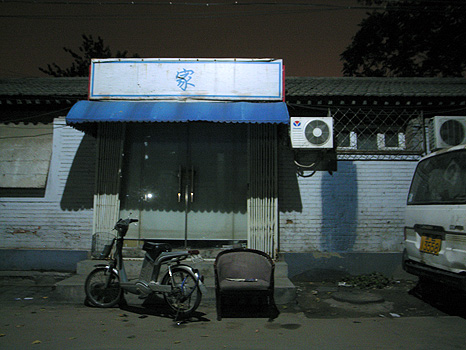
last night:The“小保安 little bodyguard”is harmonized.
昨天晚上:小保安被HX了。
today:We harvest a lot of mushrooms, and the little bodyguard escapes from the wall!
今天:我们收获了好多蘑菇,之后小保安给熏跑了。
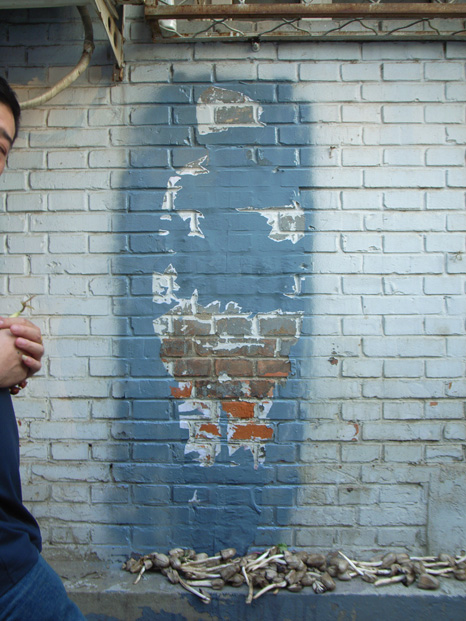

last night:The“小保安 little bodyguard”is harmonized.
昨天晚上:小保安被HX了。
today:We harvest a lot of mushrooms, and the little bodyguard escapes from the wall!
今天:我们收获了好多蘑菇,之后小保安给熏跑了。

 时间 posted on: 14 October 2010 |
时间 posted on: 14 October 2010 |  发布者 author: yinan |
发布者 author: yinan |  comments (4) |
comments (4) |
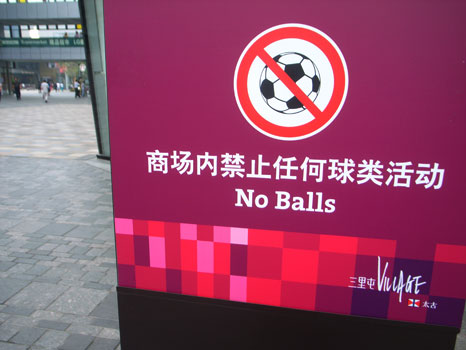
One finds oneself laughably excusing oneself before the Security Guard wearing baggy pleated shorts. At the same moment as the question emerges from the tip of my tongue (was that indignation or hesitation): Isn’t this a public space?——those wry twinges at the back of the head (very pertinent?) know all too well that a shopping mall is not a public space. What are you doing here? she asks.
Oh, hmm…uhh…I guess standing around the square and accosting people to take their pictures are not allowed. Security Guard very easily narrates her rehearsed consumer edification statement on the nature of such a “public space” as 三里屯 Sanlitun Village in East Beijing: This is the property of 太古 Taigu (Swire), and while visitors are free to regard this as a public space we do retain certain regulations and have the right to enforce them. Also inflected: consumers must be defended at all costs from anything that deters from a total shopping/dining experience, especially annoying ones like you.
Can I take your photo?
It is the perfect balance of civilised courtesy and the scenario of firm, surveyed control. We can reach the pinnacle of sophistication in an environment where we are surrounded by bourgeouis goods (I hung around to photograph one very fashionable trio, but they stayed inside Izzue for over an hour) and earphone/walkie-talkie donning young guards wearing baggy pleated shorts. It would be easy to walk away then and continue to accost Sanlitun visitors around the corner, on the other side of the square, maybe in front of the American Apparel instead of the Nike store. But you’ve been booted already, no balls, and it’s easy to begin seeing suspicious glares in all the other baggy-pleated short wearing guards that you pass every 50 meters. Go ahead and try to make friends now!
I go to an American-Italian-esque café to have a cappuccino instead. Sigh. Like my mother when she was younger, I can sit for hours on end watching people, though I wonder if my mother ever had as much longing after strangers as I do on a day like today, when I’ve been shamed for my feeble attempts at public engagement. Back then, my mother would visit the old Kai Tak airport in Kowloon Bay, and I guess I grew up in the shopping malls. It’s introductory Augé on repeat. But if these are not public spaces, perhaps we are not publics either, and I can only justifiably play fashion police as a marketing study for what trends and consumer groups should be regarded as the main influencers. To be an influencer would only then be a question of who best shines under a control scenario, under the influence of terms like ‘regime’ and ‘privatisation’ and ‘surveillance’. Is that what I like so much about the hutong still then, where life still happens under the cuff as much as it is committee-surveyed and organized for behavioural control (i.e., “文明北京人 civilised Beijinger”) as any of our more cosmopolitan world alternatives?
Maybe things are not tested as much as they could be. It felt sheepish to receive in an e-mail today: keep pushing the threshold. Playing ballsy? What does that mean, exactly? I would have liked to have written a treatise on ballsy-ness by now, but I sit instead at an American-Italian-esque café thinking too much about people who could care less. “Beyond” could be like a Badiou-ian truth, but vectorless possibilities and ballsy-ness require some form of immanence to be pushed. And where does interior exist in a control society? Are these the parameters of ‘post-privacy‘? We are all influenced. All captured and captivated and de-humanised.
 时间 posted on: 17 September 2010 |
时间 posted on: 17 September 2010 |  发布者 author: e |
发布者 author: e |  comments (4) |
comments (4) |
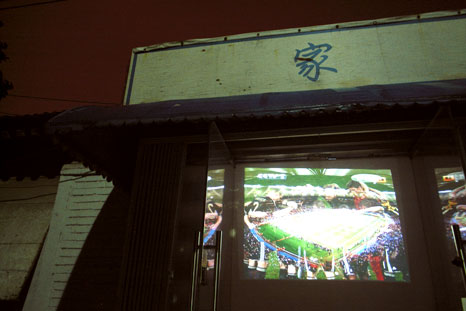
The protracted last few weeks have been pinpointed by gradually diminishing sets of binaries wrought with tension, spectacle and amazing footwork. Of course, for the less than fanatic, it may be easy to toss it all off to them and let them deal with their own battles. It’s not on our turf, where the West’s enormous chatter of the postcolonial “have not planted roots in the deep soil of Chinese culture (没有在中国文化的深厚土壤中扎下根).” But Brother GAO still loves football, and he broadcasts every game he can, live from his home simultaneous to his daily stereo sounds of Teresa TENG at Xiaojingchang number 6. Chinese football may not show as much signs of promise as its art world, yet both are intertwined with “an unprecedentedly complex cultural atmosphere flooded with paradoxes (一个空前复杂、充斥着悖论的文化境遇)” and conflict. Binaries, perhaps? Is it the East vs. West question that critics such as 许江 XU Jiang and 高士明 GAO Shiming are tired of, or simply the West? Who wears the jersey of the “monotonous cultural other (一个单调的文化他者)”?
Tonight is an exception of the third option. Old man ZHANG says it’s too late to party, but our longitude outside of prime time means that the spectacle must find other subjectivities. The third place is runner up in the exceptional case, when winners are unable to fulfill their duties. To play this role is a flailing response to the call of face, unavoidable obligation whether anybody cares or not. Spectacle unseen, it can only be personal. QU says that desire is the necessary first step that he can admire due to his own lack, but inefficacy mated with desire is a flailing third place, one can do no other.
Documentation is a justification for the things that do not appear, or do not appear to be so. We may enter the space of the event, but what takes place? Is this personal or public (her questions explode artistic catharsis as a question of an indifferent socius)? I watched the third place game of the World Cup alone in the street in the middle of the night as a sort of subjective gesture of out-of-placeness. What Pelin TAN calls this “un-relation to space” is still a question of relation, however, albeit one with increasing suspicion of its rupture. “…what needs to be accomplished can fail. Micropolitics, affective politics, seeks the degrees of openness of any situation, in hopes of priming an alter-accomplishment.” (Brian Massumi)
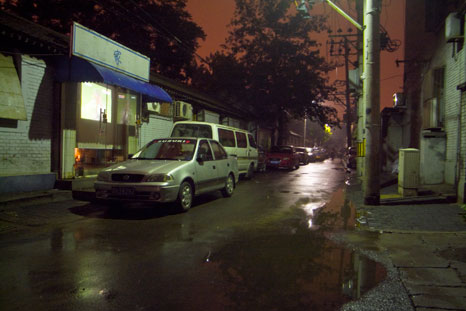
Is the third place an alter-accomplishment? Is being out of context a monotonous cultural alterity? Are you really happy about that?
——
 时间 posted on: 11 July 2010 |
时间 posted on: 11 July 2010 |  发布者 author: e |
发布者 author: e |  comments (5) |
comments (5) |
HomeShop’s friends at Instant Hutong, just a few streets down at Mao’er Hutong, are hosting an audience-participation-encouraged-happening-event at their courtyard this Sunday from 4 pm. Drop by if you can, it’s intimacy for extremists!
家作坊的朋友”胡同瞬间“很诚挚的邀请您参加负载能力活动。该活动举办时间为6月6日从下午四点开始,活动地点在帽儿胡同我们的院子内。活动中,胡同瞬间将使用一间传统北京平房作为极限挑战地。在挤压情况下,30平米的房子能装下多少人?如果他们能召集到200名参与者,该活动就能成功。因此,请大家广泛宣传他们的活动,以便有兴趣的人都能来参加。 这项活动将持续约1小时,将要求所有与会者的积极参与.
地址 address: 北京市东城区南锣鼓巷帽儿胡同14号 / no.14, Mao’er Hutong, NanLuoGuXiang, Dongcheng District
 时间 posted on: 5 June 2010 |
时间 posted on: 5 June 2010 |  发布者 author: 家作坊 HomeShop |
发布者 author: 家作坊 HomeShop |  评论 comment (0) |
评论 comment (0) |
This is a sound walk that 谢婷婷 Hailey Xie and i made in January, seven days after another big snow storm in Beijing. It was originally intended as material for the second issue of wear journal, but it felt a pity to turn all of these sounds into text-only format. We ended up leaving it out, though now in light of a recent conversation with Bruno and Hlynur in Buenos Aires, we could imagine the winter again.
I am walking with the ZOOM H4n digital recorder with built-in mics (now panned for left ear), Haxi is using a minidisc player and Sound Professionals in-ear binaural mics (now panned for right ear). If you listen carefully you’ll hear some things in a strangely layered effect, though i’m sorry though to say, i’ve destroyed the binaural in putting our tracks together. Here’s from the doorstep of HomeShop to the edge of the alleyway, before everything gets lively. Download the mp3 version [256kb/s, 11.4 mb] here.
When I was exporting the file for this, somehow the file became corrupted and time-stretched… Thought some of you might enjoy that, too.
 时间 posted on: 27 May 2010 |
时间 posted on: 27 May 2010 |  发布者 author: e |
发布者 author: e |  comment (1) |
comment (1) |
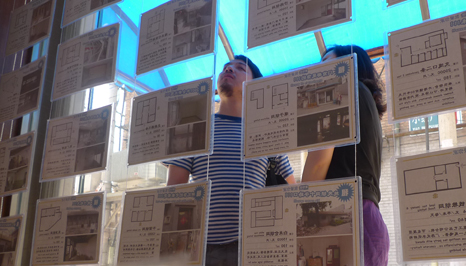
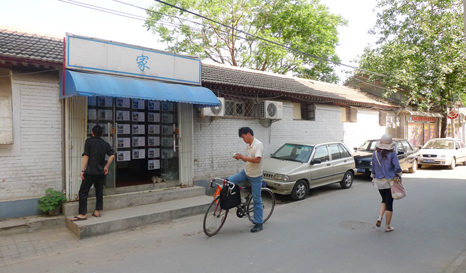
After a prolonged research and analysis period highly implicated by HomeShop’s recent search for a new space, our newfound expertise has led to the temporary return of the current space at Xiaojingchang hutong to its former status as real estate agency (pre-2007 era). We are pleased to inform you that we are taking up a new role as an offshoot office of the well-known chain 我爱我家 Wo Ai Wo Jia (“I Love My Home”), henceforth named 我爱你家 Wo Ai Ni Jia (“I Love Your Home”). If you are looking for a new house or office within Beijing’s old city centre or are merely interested to learn more about the real estate market and private life in the capital, our multilingual agents can offer free advice and direction regarding a selection of some of Beijing’s hottest properties. We do not take commission, and while our services may be limited, our knowledge is vast. Please stop by HomeShop or telephone to make an appointment. You may reach us at any time by mobile phone at 137 1855 6089.
Thank you! We are here waiting for your trust!
—–
“我爱你家 I Love Your Home” is a project of 何颖雅 Elaine W. HO and Fotini LAZARIDOU-HATZIGOGA for HomeShop. On view from 24 May 2010.
经过家作坊对寻找新空间的一段旷日持久地研究和分析,我们现在在小经厂胡同的空间暂时回到了它过去的房产中介公司状态(2007年早期)。我们很高兴的通知您,我们现在成为了著名连锁机构“我爱我家”的分店之一,并从此叫做“我爱你家”。如果您正在北京老城区的中心地带寻找房子或者办公室,或者至少对首都房地产市场和个人生活感兴趣的话,我们多语言的服务团队将为您提供免费咨询以及对某些北京最热房产的指南。我们不收取中介费,虽然服务项目有限,但我们的知识很丰富。请在家作坊门前留步,或电话预约。您可以在任何时间通过这个手机号码找到我们:13718556089。
谢谢!我们期待您的信任!
——
“我爱你家 I Love Your Home” 是由何颖雅 Elaine W. HO 及 Fotini LAZARIDOU-HATZIGOGA为家作坊做的一个项目。从2010年5月24日开始。
 时间 posted on: 25 May 2010 |
时间 posted on: 25 May 2010 |  发布者 author: f |
发布者 author: f |  comments (4) |
comments (4) |
e-publicspace.net – Public Space Encyclopedia
As part of a research project entitled UrbansSystems/Urban Models (USUM) that brings together Laboratories of ETHZ (Studio Basel), Università della Svizzera italiana, and EPFL, a specific research on public space is being undertaken by the lab. Chôros (http://choros.epfl.ch). This research confronts theory and empiricism and attempts to analyze the complexity of public spaces in cities. Is public space a universal concept?
Creating e-publicspace.net : an Encyclopedia of public space
For this research, we are creating a website which will be an Encyclopedia of public space. we are looking for documents and projects on this issue: texts (theory, anthology, bibliography), images (photographs, videos, maps, drawings) and sounds. If you are geographer, urban planner, architect, engineer, artist, sociologist, landscape historian, philosophers, political scientists, etc. you can contribute to e-publicspace.net.
Instructions
All documents are Royalty Free and should be sent by mail to the webmaster Annelore Schneider : annelore@collectif-fact.ch
Image format: one side of the image should be at least 1024 pixels.
Images and videos weight: if they exceed 6MB send them via ftp.
Languages of texts: English or French
Languages for images, videos and sounds (interviews): English, French, Spanish, Italian, German. No translation will be made.
Language for the legends of visual documents and sounds: English.
All documents must be dated.
All documents will be accompanied by a proposal for 5 keywords in English.
For more information, please contact Véronique Mauron, project manager at veronique.mauron@epfl.ch.
 时间 posted on: 29 April 2010 |
时间 posted on: 29 April 2010 |  发布者 author: b |
发布者 author: b |  comment (1) |
comment (1) |
Below is an excerpt from an essay by curator/critic Steven L. Bridges concerning contemporary practices in art in the public sphere. Let’s hope this doesn’t sound too pretentious, but sometimes you feel like someone knows exactly what you’re going through… (and they’re a lot more well-versed at it than you are) Thank you to Doug Lewis, for indirectly leading me to it. The full essay can be found here.
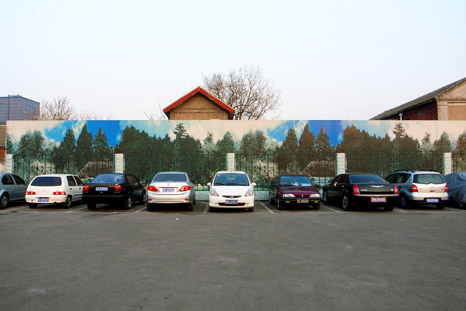 photo from me, February 2010
photo from me, February 2010
The current climate surrounding contemporary art production—including recent curatorial and exhibition practices—is especially marked by an ongoing expansion of the field across disciplinary boundaries and beyond the conventional spaces of display and reception. This expanding field of artistic production spreads in multiple directions, an expanding universe without any definite center or edge. One facet of this expanding field concerns the arm of contemporary art production today that takes the very nature of human relations as the source material for the undertaking of a project or research initiative. In doing so, artistic processes are combined with social processes of transformation through the “making visible” of that which is otherwise invisible: that is, the very socio-politico-economic tensions and power relations that organize societal life, as well as the “invisible” people within society, the marginalized and/or disenfranchised.
Many projects of socially engaged, collaborative art are highly complex systems that entangle both aesthetic and socio-politico-economic issues. These kinds of practices often speak to diverse groupings of people, who—while deeply interconnected—may or may not have access to the necessary socially, culturally or politically viable opportunities for the articulation of their personal views and concerns, their own subject positions. This type of working process—layering aesthetic and sociopolitical issues; employing open-ended, dialogical modes of production; testing the very publicness of the spaces in which the work permeates—requires a kind of artistic and curatorial prowess that focuses on notions of collaboration, representation and improvisation. Yet, the very mutability of these practices does much to dissuade the use of oversimplified categories and concepts, and without sufficient tools (theoretical or practical) to measure and gage their multiple values and points of reception, analysis can often lead to a reduction of the works to a single dimension or create a misleadingly narrow critical framework.
In order to avoid the numbing effects that accompany the use of generic terms—the pitfalls of overgeneralization—I will take a moment to further explore the concepts of collaboration and representation in the hopes of reactivating them within the context of this analysis. My interest in collaborative processes extends far beyond merely the definition of two or more people “working together.” This is a rather mundane interpretation and does not convey the sense of reciprocal activation—processes that create a sense of agency and empowerment among the participants that they may not otherwise put into practice—that is fundamental to collaboration. The exhibitions, and works of art within, develop situations for the expression of multiple subject positions, and it is through these kinds of exchanges that the possibility for change is enacted, with careful attention paid to the aesthetic potential of the communicative act. Above all, these projects come to function as critical sites of debate and contestation, a form of productive interaction that invariably metabolizes the different viewpoints of those involved in order to produce other viewpoints to be mulled over and debated. Such processes are ultimately dialectical in nature, productive in their sustained oppositionality and interconnectedness.
—
Read the rest of “Making the Invisible Visible: A City in Multiples and the Art of Multiplicity“.
 时间 posted on: 23 February 2010 |
时间 posted on: 23 February 2010 |  发布者 author: e |
发布者 author: e |  评论 comment (0) |
评论 comment (0) |
I can’t remember if I posted this paper already or not, but since I was reading it again for course I’m teaching, I thought you might find it interesting as well. You probably know Zhang Dali’s work already, but I think this paper has some interesting interpretations of his work and raises impoortant issues on the relationship between artist/city/public sphere.
Here is the abstract:
Walls of Dialogue in the Chinese Space
M. Marinelli
Since the early 1980s, Beijing has been undergoing a period of phenomenal structural transformation and immense growth, as a consequence of the open door policy. The dramatic change of the Chinese capital has progressively forced its inhabitants to face the challenge of managing the fabric and culture of the urban environment in order to adapt to a new city, while burgeoning nationalism and the development of local and international tourism have constructed Beijing as a showcase for national identity. Day after day the traditional houses (siheyuan) and tiny alleyways (hutong) of Beijing are destroyed, neutralized, and rebuilt to turn the capital into an international metropolis. This article focuses on the graffiti and performance artworks of Beijing-based Zhang Dali — one of the artists most concerned with the transformation of the city. The human head profile that invaded the Beijing cityscape in the 1990s — often found inscribed on the walls and buildings demarcated for destruction (chai) — is called “Dialogue” (duihua). It is a figurative symbol that cannot escape attention.
Investigating Zhang’s work through the lens of Foucault’s and Benjamin’s theoretical approaches to history, this article deals with the relationship between subjective representation and spatial transformation, and raises the critical question of artistic agency in public space.
 时间 posted on: 13 March 2009 |
时间 posted on: 13 March 2009 |  发布者 author: b |
发布者 author: b |  评论 comment (0) |
评论 comment (0) |
Have you seen that one? interesting I think about what it means to be a citizen…interesting as well to see that European cities are rather losing such kind of civilized manners…and I’ve been spotting more and more signs and boards reminding people how they should behave. For example, a new subway just opened in Lausanne, and it is not working, most of the time, because of people’s behavior, so they are trying to educate them…
A Comedy of Manners: The Public Behavior Civilization Index
(http://www.thebeijinger.com/blog/2008/10/28/A-Comedy-of-Manners-The-Public-Behavior-Civilization-Index)
Submitted on Oct 28, 2008 11:00am by Mandy Li, Paul Pennay
According to the latest figures from the Humanistic Olympic Studies Center (人文奥运研究中心) at the People’s University of China (Renmin Daxue), Beijing’s citizens are becoming more polite. The center maintains a public behavior civilization index (北京市民公共行为文明指数) that attempts to put a figure on how civilized residents of the capital (including laowai) really are. The index is based on an annual survey of 12,000 randomly chosen Beijing residents along with 1,200 long-term expats (must have lived in the city for more than 2 years). The center also takes into account 3,000 hours of observation of 400,000 pedestrians and 390,000 vehicles at 360 public places across the city when calculating the figure.The latest results of the Humanistic Olympic Studies Center’s research were released yesterday, it revealed that Beijing residents are now paying more attention to their behavior and manners in public places than ever before. The figure for this year’s results is 82.68 (100 would mean that there was absolutely no bu wenming behavior talking place) and is a vast increase on the score of 65.21 achieved in 2005. Like the numbers of “blue sky” days, the PBCI has increased at a constant rate in the lead up to the Olympics. In 2006 Beijingers had achieved a mark of only 69.06 in terms of their manners and in 2007 this had improved to 73.38.
According to the report, there has been a marked decrease in the number of people jumping queues while waiting for a bus, jaywalking, littering and spitting. There has also been an increase in the willingness of residents to give directions and give up their seats to others on public transport.
2008 -> 2007 -> 2005
Jumping the queue while waiting for the bus 2.2% -> 5% -> 38%
Jaywalking 0.49% -> 2.5% -> 24%
Littering 1.1% -> 2.86% -> 9.1%
Giving up your seat 98% -> 95% -> 76%
Giving directions and help 97% -> 95% -> 71%
Links and Sources
Humanistic Olympic Studies Center
Sdinfo.net: 调查显示:北京市民公共行为文明指数显著提升
Qianlong: 北京市近日调查显示市民公共文明指数显著上升
 时间 posted on: 12 March 2009 |
时间 posted on: 12 March 2009 |  发布者 author: b |
发布者 author: b |  评论 comment (0) |
评论 comment (0) |